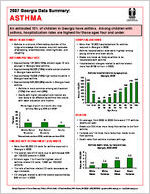2007 Georgia Data Summary:
ASTHMA
An estimated 10% of children in Georgia have asthma. Among children with asthma, hospitalization rates are highest for those ages four and under.
WHAT IS ASTHMA?
Asthma is a chronic inflammatory disorder of the lungs and airways that causes recurrent episodes of wheezing, breathlessness, chest tightness, and coughing.
ASTHMA PREVALENCE
Approximately 137,000 (10%) children ages 10 and younger in Georgia have asthma.
Approximately 56,000 (15%) middle school students in Georgia have asthma.
Approximately 70,000 (16%) high school students in Georgia have asthma.
Approximately 540,000 (8%) adults in Georgia have asthma. Asthma is more common among adult women (10%) than adult men (6%). Adults with higher education and income are less likely to be affected by asthma than adults with lower education and income.
Percent
Percentage of youth and adults w ho have asthm a, Georgia, 2005 and 2006*
50
40
30
20
15
16
10
0
Middle School High School
Stude nts
Stude nts
8 Adults
*Student data are from 2005; adult data are from 2006.
EMERGENCY DEPARTMENT (ED) VISITS
More than 50,000 ED visits for asthma occurred in Georgia in 2005.
The overall rate of ED visits due to asthma was 549 per 100,000 persons in 2005.
Children ages 1 to 4 had the highest rate of asthma-related ED visits; 1,562 per 100,000 persons.
The rate of asthma-related ED visits decreases as age increases.
ED charges related to asthma totaled approximately $46 million in 2005.
HOSPITALIZATIONS
More than 12,000 hospitalizations for asthma occured in Georgia in 2005.
Asthma hospitalization rates were highest among young children and older adults.
Blacks are twice as likely as whites to be hospitalized with asthma.
Hospitalization charges related to asthma totaled more than $126 million in 2005.
Rate per 100,000
Asthma hospitalizations by age group,
400 350 323
Georgia, 2005
314 333
300
244
250
200 142
177 148
150
89
100
38 48
50
0 0-4 5-14 15- 25- 35- 45- 55- 65- 75- 85+ 24 34 44 54 64 74 84
Age Group
DEATHS
On average, from 2000 to 2005 there were 117 asthma deaths per year.
Blacks are 2.6 times more likely than whites to die from asthma.
Females are 1.6 times more likely than males to die from asthma.
Death rates from asthma increase with age.
Rate per 100,000
Asthma death rates, by race and sex, Georgia, 2000-2005
5
4
3.2
3
2.4
2
0.8
1.4
1
0
White
White
Black
Black
Males Females Males Females
Georgia Department of Human Resources, Division of Public Health 2 Peachtree Street, NW Atlanta, GA 30303 (404) 657-3103 ga-asthma@dhr.state.ga.us http://health.state.ga.us
CHILDREN: Medicine Use
84% of children with asthma use prescription medications, including 36% with prescriptions for control and quick-relief medications, 14% with a prescription for control medications only, and 34% with a prescription for quick-relief medications only.
17% of children with asthma use two or more prescriptions per year.
Use of asthma prescription medicines among children with asthma, Georgia, 2002-2003
40
34
36
30
Percent
20
16
14
10
0
No
Quick Relief Control Only Quick Relief
Prescription
Only
and Control
Medication
CHILDREN: Asthma Management and Training
60% of children with asthma have had an asthma attack in 2002-2003.
About 75,000 (48%) children ages 5 to 17 reportedly missed approximately 470,000 school days due to their asthma.
About 48,000 (23%) children with asthma reported having limitations in their daily activity, compared to their friends.
ADULTS: Asthma Management
56% of adults with asthma reported having had an episode of asthma or an asthma attack in 2005.
14% of adults with asthma reported they were unable to work or carry out usual activities on one or more days.
42% of adults with asthma reported having no routine checkups for their asthma.
Control medications: medicines designed to control airway inflammation and prevent attacks from occurring.
Quick-relief medications: medicines designed to provide quick relief of asthma symptoms during an attack or exacerbation.
ASTHMA PREVENTION
Know the common triggers
Exposure to the following environmental irritants and allergens can cause an asthma attack:
Tobacco smoke Dust mites Pets (animal dander) Cockroaches Fungi and molds (indoor and outdoor)
Take control of asthma
Reduce exposure to your triggers. Work with your doctor to create an asthma
management plan. Monitor your breathing and airways with a peak
flow meter, as recommended by your doctor. Treat symptoms early. Learn when to seek medical help.
Create an asthma management plan
An asthma management plan is a written guide set up by your doctor and you to help manage your asthma, based on your individual needs.
Your plan will tell you:
What brings on your asthma symptoms. How to avoid triggers and reduce exposure. What medicines to take and when to take
them. When you need to seek medical help.
Tips for using an asthma management plan:
Go over each step of the plan with your doctor. Understand instructions for medications. Learn to use equipment, such as nebulizers,
properly. Schedule routine visits to discuss your asthma
with your doctor. Let your doctor know if your plan is not
working, so that the plan can be revised as needed.
Data sources:
1. 2006 Georgia Behavioral Risk Factor Surveillance System (BRFSS) (http://health.state.ga.us/epi/brfss/publications.asp). 2. 2005 Georgia Youth Tobacco Survey (http://health.state.ga.us/epi/cdiee/tobaccouse.asp). 3. Georgia Vital Statistics, 2005 4. Georgia Hospital Inpatient Discharge Data, Office of Health Information and Policy (OHIP), 2005 5. 2002-2003 Georgia Childhood Asthma Survey
Date updated: August 2007 Publication number: DPH07/114HW Visit http://www.health.state.ga.us/epi/cdiee/asthma.asp for more information about asthma in Georgia.
Georgia Department of Human Resources, Division of Public Health 2 Peachtree Street, NW Atlanta, GA 30303 (404) 657-3103 ga-asthma@dhr.state.ga.us http://health.state.ga.us
